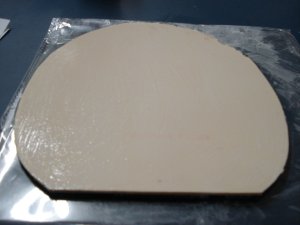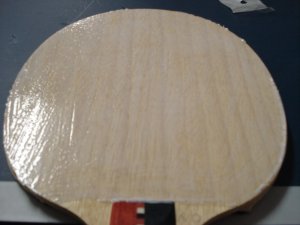"Normal
contact glue water based. Apply a layer on the blade and on the rubber,
let it dry 30-45 minutes and join the rubber on the blade. When you remove
the rubber from the blade, the residue could become glue again with a
small quantity of water. To clean, apply a small quantity of water and
scrub with a wet sponge.
Large
brush for easy gluing.
This
glue sticks perfectly well, is easy to clean with water, and works really
well with the Falco Tempo Booster.
Another feature of this 100% water glue is that the dry residue on the
blade becomes glue again if you apply a spoon of water!"
Instructions
/ Review (by Alex)
This is a true water-based glue for attaching any rubber to your
blade. The liquid comes in a 150ml tin, with a nice and thick brush for
spreading. The liquid is white and quite thick, but dries clear.
There is some confusion about how to use this glue,
as the instructions above are quite different to those on the tin as outlined
below.
1. Applying the glue to rubber
Put the rubber onto a flat surface (sponge up) and apply a thin
layer of glue to it. I recommend only a very thin layer, since after you attach
the rubber and blade together layer and clamp in step 7, you'll squeeze out any
excess glue anyway, which is both a waste and makes a mess... Since the
liquid is quite thick, very small strokes makes it much
easier to spread it thin and evenly.
Note that the sheet below is cut already, but the procedure
below will still work if you cut the rubber after it's been glued. Cutting the
rubber before you glue it onto the bat is quite a good option, and can makes
things easier as illustrated below, but may not give quite as clean a finish as
cutting it afterwards.

2. Applying the glue to blade
Similarly put a thin layer onto the blade

3. Wait till glue starts to dry
Now we need to wait for some time before we put the two
together, and this is where the confusion came in for me; The instruction on the
tin tell you to wait 1-2 hours for the glue to dry, whereas the instruction
above (also from the manufacturer) tell you to wait 30-45mins.
The first time I tried this glue I waited for more than an hour
for the glue to dry. When I inspected them, both were completely dry, with no
adhesive strength at all!
After discussing this with the manufacturer, it was recommended
to just wait long enough for the glue to start to become clear (from it's
initial white colour), and at this point it's ready to be attached together. For
me it was more like 20mins for this to happen, but it obviously depends a lot on
climate conditions...
Tip: If you've accidentially left it too long and
the glue has already dried, simply wipe it with a web cloth once or twice, which
will soften it up again. Wipe it only lightly, or you'll remove too much glue.
4. Applying the rubber and blade together.
When the glue starts to turn clear (from it's initial white
colour) the rubber and blade are ready to be applied together. This is a simple
matter of lining up the label on the rubber to the blade just above the handle,
and putting down the rest of the rubber onto the blade.
The good thing about this glue is that it's still not completely
dry, so even after you've put the rubber onto the blade, you can still move it
around a little if it's not on straight.
Use a roller or round bottle to roll onto the surface to squeeze
out any air bubbles underneath, taking care that the rubber does not move around
too much. If it move, simple adjust it again.
5. Cut or clamp?
At this point you need to decide if you wish cut the sheet first
(if it's not already cut), or clamp the rubber first.
If you cut the sheet at this point, you need to be careful you
don't move it around too much and get it out of alignment again.
If you clamp it first, the alignment is not an issue, but the
process will take longer since you've have to wait till after clamping before
you can put the other side on (if you have to glue both sides. Also your bat may
not fit the clamp with the rubbers uncut.
6. Cutting
To cut the rubber, either use small sharp scissors, or a real
sharp knife, like a box-cutter knife or a scalpel. Scissors may be easier, but
don't usually give as neat a cut. The key with a knife is to take several passes
before you cut through the whole rubber... this gives a cleaner cut.
If the glue is still wet when you cut, you mainly have to watch
the alignment of the rubber. If the glue is already dry, watch out carefully for
hard bits of glue that have squeezed out, as cutting them is harder and may tear
the sponge a little if you're not careful.
Cutting the rubber before you start the gluing process is quite
a good option too. Simple place the blade into the back of the rubber and draw
the outline of the blade onto the sponge, than cut it with small and sharp
scissors, with only very small cuts at the time.
Tip: Having the scissors a little wet makes it
easier to cut cleanly
7. Clamping
A proper bat clamp, or another type of press, or even a stack of
books can be used for clamping. Do not clamp too tight, only just enough to make
sure the rubber is in contact with the blade around the edges. If you clamp
harder, you'll squeeze out some of the glue, making the adhesion less, and can
push out some drop of glue, which when they dry will make it harder to cut the
rubber.
As soon as you've tightened the clamp, check for glue being
squeezed out around the edges. If there a fair bit of glue, it would be good to
clean this off (with a wet cloth) first, before it hardens....
8. Drying times:
After clamping the rubber seems to be well attached within an
hour, but it's likely that stronger adhesion is acquired after longer period.
9. Removing the rubber (if required)
If you need to remove the rubber at a later stage, either for
speed glueing or just for replacing or trying a different rubber, it is quite
simple with this glue. You can simply pull it off, starting at a corner where it
may be a little loose already. if you do it slowly and carefully, it should come
off without any damage to either the rubber or blade. Pull at 45 degree to the
direction of the fibre of wood, which reduces the chance of pulling off fibres
off the blade. I have not found this to be an issue with this glue though.
Both the rubber and the blade can easily be cleaned with a wet
cloth, as the glue simply softens up and wipes off. This is a huge advantage
with this glue, as getting it off with other types of glue can be a huge
pain.
If you're going to put on another rubber, no need to remove the
glue from the blade... simple make it wet again by gently wiping it with a wet
clot (don't wipe too hard or too often or you'll remove the glue) and it will
soften again, ready to be used for another rubber! This is a real bonus with
this type of glue!
10. Conclusions:
This glue is a little trickier to use than the normal table
tennis glues, but also has some significant advantages;
1. It is MUCH safer to use than normal table tennis glue.
2. When the ITTF VOC-based glue ban comes into effect, normal
table tennis glues can no longer be used.
3. It is actually water based, and can easily be removed with
water. Although there are some other VOC free products coming onto the market,
not all are actually water based, and may need solvents to be cleaned
off the surface of the blade or rubber.
4. Glue can be re-activated simply with water.
5. The bond is strong enough to hold the rubber on really well,
but not too hard to remove, and I see the risk of pulling off fibres from the
blade as much lower compared to normal table tennis glues.
NOTE: One of a Kind Trading is the sole
distributor for Australia & New Zealand for the Berenger Falco products. If
you are interested in being a distributor of these products for your area,
please contact us. We can be contacted via Email: lunavander@internode.on.net
or our table tennis forum
or our table tennis ONLINE store